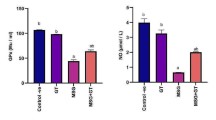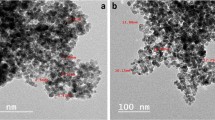Abstract
The present study was designed to investigate the prophylactic effect of extracts of the brown alga Padina boergesenii against potent nephrotoxic agent ferric nitrilotriacetate (Fe-NTA), in blood circulation of rats. Administration of Fe-NTA for seven consecutive days significantly enhanced lipid peroxidation accompanied with reduction in glutathione content. Together with this, the level of antioxidant enzymes, glutathione peroxidase, superoxide dismutase, and catalase was significantly (P < 0.05) diminished. Pretreatment of rats with P. boergesenii (150 mg kg−1 body weight) reversed Fe-NTA-induced oxidative damage in lipid peroxidation and glutathione content significantly (P < 0.05). Further, the activity of antioxidant enzymes was also restored significantly. In order to assess the role of polyphenolic components in the relevant activity, phenolic contents of the extract was found to be 1.78 ± 0.02% in the methanol extract and 1.30 ± 0.30% in the diethyl ether extract. Hence, the present results confirm that the brown alga P. boergesenii preclude its role in Fe-NTA-induced oxidative damage and hyperproliferative response in circulation.






Similar content being viewed by others
References
Ames BN (1983) Dietary carcinogens and anticarcinogens: oxygen radicals and degenerative diseases. Science 221:1256–1264
Anila L, Vijayalakshmi NR (2002) Flavonoids from Emblica officinalis and Mangifera indica—effectiveness for dyslipidemia. J Ethnopharmacol 79:81–87
Ansar S, Iqbal M, Athar M (1999) Nordihydroguairetic acid is a potent inhibitor of ferricnitrilotriacetate-mediated hepatic and renal toxicity, and renal tumour promotion, in mice. Carcinogenesis 20:599–606
Athar M, Iqbal M (1998) Ferric nitrilotriacetate promotes N-diethylnitrosoamine-induced renal tumorigenesis in rat: implications for the involvement of oxidative stress. Carcinogenesis 19:1133–1139
Awai M, Narasaki M, Yamanoi Y, Seno S (1979) Induction of diabetes in animals by parenteral administration of ferric nitrilotriacetate. A model of experimental hemochromatosis. Am J Pathol 95:663–672
Bhaskar N, Miyashita K (2005) Lipid composition of Padina tetrastromatica (Dictyotales, Phaeophyta), a brown seaweed of the west coast of India. Ind J Fish 52:263–268
Bravo L (1998) Polyphenols: chemistry, dietary sources, metabolism and nutritional significance. Nutr Rev 56:317–333
Chkhikvishvili ID, Ranazanov ZM (2000) Phenolic substances of brown algae and their antioxidant activity. Appl Biochem Microbiol 36:336–338
Claiborne A (1985) Catalase activity. In: Greenwald RA (ed) CRC Handbook of methods for oxygen radical research. CRC, Boca Raton, pp 283–284
Cook NC, Samman S (1996) Flavonoids: chemistry, metabolism, cardioprotective effects and dietary sources. J Nutr Biochem 7:66–76
Ellman GC (1959) Tissue sulfhydryl groups. Arch Biochem Biophys 82:70–77
Harman D (1981) The aging process. Proc Natl Acad Sci USA 78:7124–7128
Iqbal M, Rezazadeh H, Ansar S, Athar M (1998) α-Tocopherol (vitamin-E) ameliorates ferric nitrilotriacetate (Fe-NTA)-dependent renal proliferative response and toxicity: diminution of oxidative stress. Human Exp Toxicol 17:163–171
Iqbal M, Sharma SD, Rahman A (1999a) Evidence that ferric nitrilotriacetate mediates oxidative stress by down-regulating DTdiaphorase activity: implications for carcinogenesis. Cancer Lett 141:151–157
Iqbal M, Giri U, Giri DK et al (1999b) Age-dependent renal accumulation of 4-hydroxy-2-nonenal (HNE)-modified proteins following parenteral administration of ferric nitrilotriacetate commensurate with its differential toxicity: implications for the involvement of HNE-protein adducts in oxidative stress and carcinogenesis. Arch Biochem Biophys 365:101–112
Iqbal M, Okazaki Y, Okada S (2009) Curcumin attenuates oxidative damage in animals treated with a renal carcinogen, ferric nitrilotriacetate (Fe-NTA): implications for cancer prevention. Mol Cell Biochem 324:157–164
Iwai K (2008) Antidiabetic and antioxidant effects of polyphenols in brown alga Ecklonia stolonifera in genetically diabetic KK-Ay mice. Plant Foods Hum Nutr 63:163–169
Jimenez-Escrig A, Jimenez-Jimenez I, Pulido R, Saura-Calixto F (2001) Antioxidant activity of fresh and processed edible seaweeds. J Sci Food Agric 81:530–534
Kahkonen MP, Hopia AI, Vuorela HJ, Rauha JP, Pihlaja K, Kujala TS et al (1999) Antioxidant activity of plant extracts containing phenolic compounds. J Agric Food Chem 47:3954–3962
Kakkar P, Das B, Viswanathan PN (1984) A modified spectrophotometric assay of superoxide dismutase. Indian J Biochem Biophys 21:130–132
Kang HS, Chung HY, Jung JH, Son BW, Choi JS (2003) A new phlorotannin from the brown alga Ecklonia stolonifera. Chem Pharm Bull 51:1012–1014
Kang HS, Chung HY, Kim JY, Son BW, Jung HA, Choi JS (2004) Inhibitory phlorotannins from the edible brown alga Ecklonia stolonifera on total reactive oxygen species (ROS) generation. Arch Pharm Res 27:194–198
Kehrer JP (1993) Free radicals as mediators of tissue injury and disease. CRC Crit Rev Toxicol 23:21–48
Khan N, Sharma S, Sultana S (2004) Attenuation of potassium bromate-induced nephrotoxicity by coumarin (1,2-benzopyrone) in Wistar rats: chemoprevention against free radical-mediated renal oxidative stress and tumor promotion response. Redox Rep 9:19–28
Lim SN, Cheung PCK, Ooi VEC, Ang PO (2002) Evaluation of antioxidative activity of extracts from brown seaweed, Sargassum siliquastrum. J Agric Food Chem 50:3862–3866
Mohandas J, Marshall JJ, Duggin GG, Horvath JS, Tiller D (1984) Differential distribution of glutathione and glutathione related enzymes in rabbit kidney: possible implications in analgesic neuropathy. Cancer Res 44:5086–5091
Nakamura T, Nagayama K, Uchida K, Tanaka R (1996) Antioxidant activity of phlorotannins isolated from the brown alga Eisenia bicyclis. Fish Sci 62:923–926
Nichans WG, Samuelson B (1972) Formation of malondialdehyde from phospholipid arachidonate during microsomal lipid peroxidation. Eur J Biochem 6:126–130
Okada S (1995) Iron-induced tissue damage and cancer: the role of reactive oxygen species-free radicals. Pathol Int 19:339–347
Rice-Evans CA, Miller NJ, Paganga G (1997) Antioxidant properties of phenolic compounds. Trends Plant Sci 2:152–159
Rios JJ, Gutiérrez-Rosales F (2010) Comparison of methods extracting phenolic compounds from lyophilized and fresh olive pulp. LWT - Food Sci Tech 1–4
Rioux LE, Turgeon SL, Beaulieu M (2007) Characterization of polysaccharides extracted from brown seaweeds. Carbohyr Polym 69(3):530–537
Shahidi F, Naczk M (2004) Phenolics in food and nutraceuticals. CRC, Boca Raton
Sies H (1993) Strategies of antioxidant defense. Eur J Biochem 215:213–219
Sies H (1995) Strategies of antioxidant defense: relations to oxidative stress. In: Packer L, Wirtz K (eds) Signalling mechanisms from transcription factors to oxidative stress, Springer, Berlin, pp 165–186
Singleton VL, Rossi JA (1965) Colorimetry of total phenolics with phosphomolybdic-phosphotungstic acid reagents. Am J Enol Vitic 16:144–158
Sook HH, Young CH, Young KJ, Who SB, Ahand JH, Sue CJ (2004) Inhibitory phlorotannins from the edible brown alga Ecklonia stolonifera on total reactive oxygen species (ROS) generation. Arch Pharm Res 27:194–198
Wang BG, Zhang WW, Duan XJ, Li XM (2009) In vitro antioxidative activities of extract and semi-purified fractions of the marine red alga, Rhodomela confervoides (Rhodomelaceae). Food Chem 113:1101–1105
Wattenberg LW (1985) Chemoprevention of cancer. Cancer Res 45:1–8
Wiseman H, Halliwell B (1996) Damage to DNA by reactive oxygen and nitrogen species: role of inflammatory disease and progression to cancer. Biochem J 313:17–29
Wong CK, Ooi VEC, Ang PO (2000) Protective effects of seaweeds against liver injury caused by carbon tetrachloride in rats. Chemosphere 41:173–176
Xi WY, En LZ, Fen HY, Hong XZ (2003) Inhibition of mouse liver lipid peroxidation by high molecular weight phlorotannis from Sargassum kjellmanianum. J Appl Phycol 15:507–511
Yuan YV, Walsh NA (2006) Antiooxidant and antiproliferative activities of extracts from a variety of edible seaweeds. Food Chem Toxicol 44:1144–1150
Yuan YV, Bone DE, Carrington MF (2005) Antioxidant activity of dulse (Palmaria palmata) extract evaluated in vitro. Food Chem 91:485–494
Acknowledgments
We are grateful to Dr. P. Subramanian, Reader, Department of Biochemistry and Biotechnology, Annamalai University for valuable support in technical aspects. The authors wish to thank Department of Biotechnology (DBT), India for the financial support. Finally, the authors would like to acknowledge the three anonymous referees for their constructive criticism and their help to clarify and improve this manuscript.
Author information
Authors and Affiliations
Corresponding authors
Rights and permissions
About this article
Cite this article
Karthikeyan, R., Manivasagam, T., Anantharaman, P. et al. Chemopreventive effect of Padina boergesenii extracts on ferric nitrilotriacetate (Fe-NTA)-induced oxidative damage in Wistar rats. J Appl Phycol 23, 257–263 (2011). https://doi.org/10.1007/s10811-010-9564-0
Received:
Revised:
Accepted:
Published:
Issue Date:
DOI: https://doi.org/10.1007/s10811-010-9564-0




